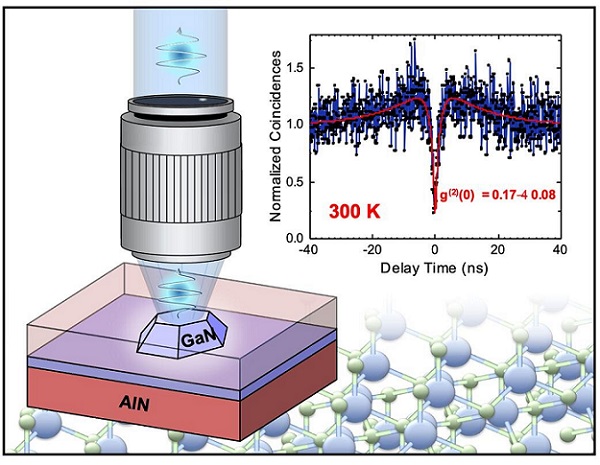Scientists at École polytechnique fédérale de Lausanne (EPFL) have developed a single-photon emitter capable of room temperature operation. The technology is based on quantum dots grown on cost-effective silicon substrates.
Developing nonclassical light sources that can emit exactly one photon on demand is one of the main requirements of quantum technologies. While the first demonstration of single-photon emitters dates back to the 1970s, their low reliability and efficiency has stood in the way of practical use.
The researchers at EPFL, led by professor of physics Nicolas Grandjean, said they have developed “bright and pure” single-photon emitters based on wide bandgap semiconductor quantum dots grown on cost-effective silicon substrates.

Single-photon emission by a self-assembled gallium nitride/aluminum nitride quantum dot. These quantum dots were grown on silicon substrates, supporting a single-photon emitter that operates at room temperature. Courtesy of Johann Stachurski/EPFL.
The quantum dots are composed of gallium nitride and aluminum nitride and feature single-photon purity of 95% at cryogenic temperatures and exhibit excellent resilience at higher temperatures, with a purity of 83% at room temperature.
The single-photon emitter also shows photon emission rates up to 1 MHz while maintaining a single-photon purity over 50%.
“Such brightness up to room temperature is possible because of the unique electronic properties of the GaN/AlN quantum dots, which preserve the single-photon purity due to the limited spectral overlap with competing neighboring electronic excitation,” said Johann Stachurski, the Ph.D. student who investigated these quantum systems.
According to the researchers, one of the appealing features of gallium nitride and aluminum nitride quantum dots is their inclusion in the III-nitride semiconductor family. According to the researchers, this group is the second semiconductor family in terms of consumer market, after silicon, which dominates the microelectronics industry.
Accordingly, III-nitrides benefit from a solid and mature technological platform, which makes them of high potential interest for the development of quantum applications.
An important step in the work will be to determine if the platform can emit one photon and only one per laser pulse, which is an essential prerequisite to determine its efficiency.
Because the electronic excitations exhibit room temperature lifetimes as short as 2 to 3 billionths of a second, single-photon rates of several tens of MHz could be achievable, the authors said. Combined with resonant laser excitation, which is known to significantly improve single-photon purity, they believe that their quantum-dot platform could be of interest for implementing room temperature quantum key distribution based on a true single-photon detector as opposed to current commercial systems that run with attenuated laser sources.
The research was published in Light: Science & Applications (www.doi.org/10.1038/s41377-022-00799-4).